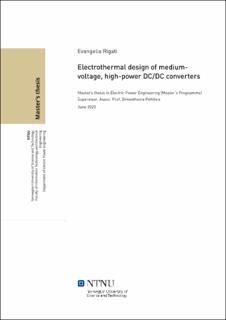| dc.description.abstract | The ever-increasing demand for electrical energy globally and simultaneously the need for clean energy have played an important role in the penetration of renewable energy sources to the electric power distribution grid. As a result, a rapid shift from medium voltage alternating current (MVAC) to medium voltage direct current (MVDC) grids is observed and high power DC-DC converters would play a crucial role in the systems. Dual active bridge DC-DC converter is a quite promising topology to integrate renewables and battery energy storage systems to the MVDC grid. In order to meet the voltage and current requirements of the networks, modularized DAB converters can be developed from the fundamental block and Silicon Carbide (SiC) MOSFET switching devices can be deployed to allow operation of the converters at high switching frequencies, high temperatures and high voltage levels. These properties make them a desirable technology for the bidirectional DAB converter. During the long-term operation of the switching devices, though, failures due to temperature swings in the encapsulation of the chips in different packaging technologies are observed. As a result, there are reliability challenges that need to be tackled for an optimal operation of the MOSFETs in the converters.
This thesis deals with the electrical and thermal design and modelling of a 60 kW modularized DAB DC-DC converter employing SiC MOSFETs. The main purpose is to interconnect photovoltaics and batteries to the MVDC distribution grid. Therefore, two different system configurations have been developed, a centralized and a distributed topology. For an optimal design and operation of the system model, a control scheme has been properly developed, combining a maximum power point (MPP) controller, to track the maximum power from the PV arrays, a single phase shift controller to enable the maximum power flow through the converter and a PI controller to regulate the power flowing from and to the batteries. In order to validate the systems' performance a load profile and variations in solar radiation have been considered for both cases. The results of the system operation have been reported and discussed in terms of reliability and optimal system operation. | |
